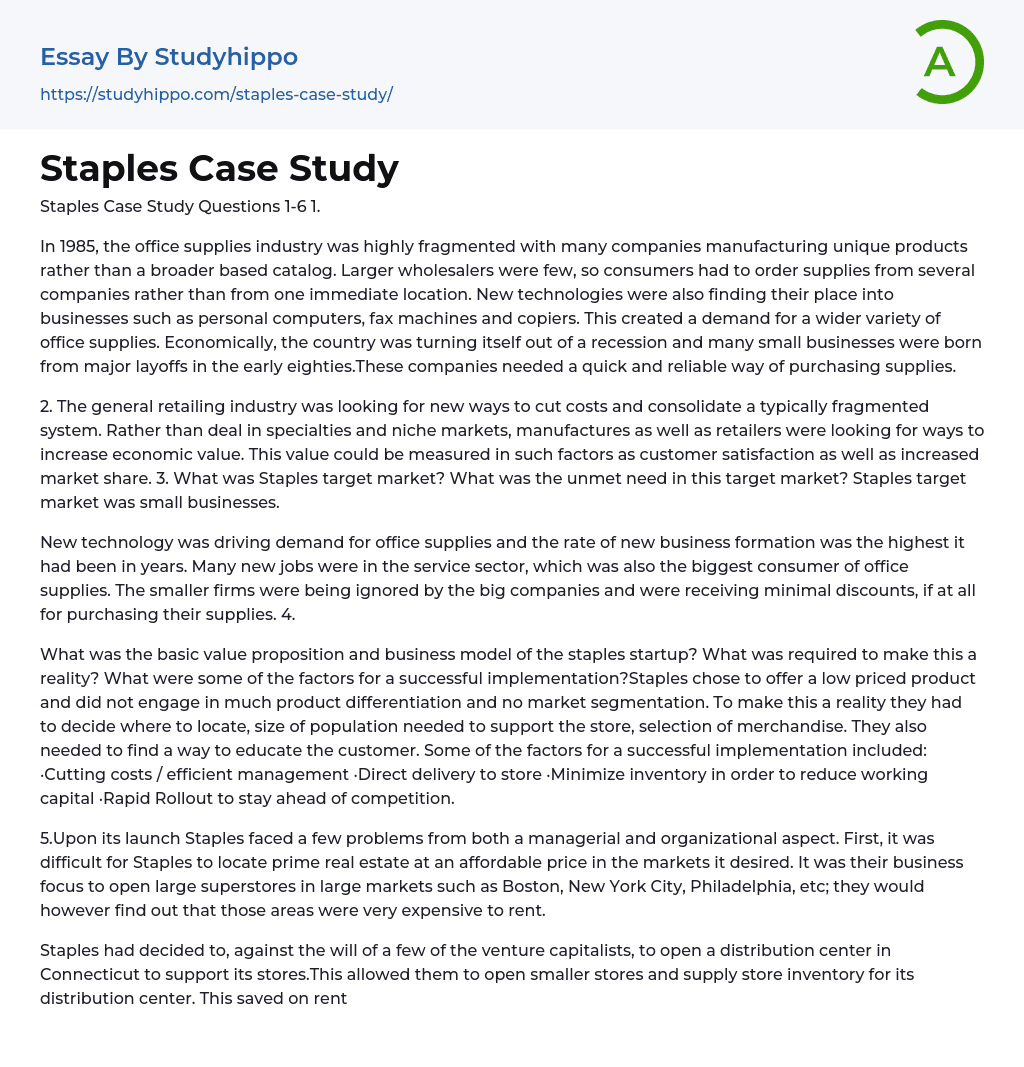Staples Case Study Questions 1-6 1.
In 1985, the office supplies industry was highly fragmented with many companies manufacturing unique products rather than a broader based catalog. Larger wholesalers were few, so consumers had to order supplies from several companies rather than from one immediate location. New technologies were also finding their place into businesses such as personal computers, fax machines and copiers. This created a demand for a wider variety of office supplies. Economically, the country was turning itself out of a recession and many small businesses were born from major layoffs in the early eighties.These companies needed a quick and reliable way of purchasing supplies.
2. The general retailing industry was looking for new ways to cut costs and consolidate a typically fragmented system. Rather than deal in specialties
...and niche markets, manufactures as well as retailers were looking for ways to increase economic value. This value could be measured in such factors as customer satisfaction as well as increased market share. 3. What was Staples target market? What was the unmet need in this target market? Staples target market was small businesses.
New technology was driving demand for office supplies and the rate of new business formation was the highest it had been in years. Many new jobs were in the service sector, which was also the biggest consumer of office supplies. The smaller firms were being ignored by the big companies and were receiving minimal discounts, if at all for purchasing their supplies. 4.
What was the basic value proposition and business model of the staples startup? What was required to make this a reality? What were some of the factors for
a successful implementation?Staples chose to offer a low priced product and did not engage in much product differentiation and no market segmentation. To make this a reality they had to decide where to locate, size of population needed to support the store, selection of merchandise. They also needed to find a way to educate the customer. Some of the factors for a successful implementation included: ·Cutting costs / efficient management ·Direct delivery to store ·Minimize inventory in order to reduce working capital ·Rapid Rollout to stay ahead of competition.
5.Upon its launch Staples faced a few problems from both a managerial and organizational aspect. First, it was difficult for Staples to locate prime real estate at an affordable price in the markets it desired. It was their business focus to open large superstores in large markets such as Boston, New York City, Philadelphia, etc; they would however find out that those areas were very expensive to rent.
Staples had decided to, against the will of a few of the venture capitalists, to open a distribution center in Connecticut to support its stores.This allowed them to open smaller stores and supply store inventory for its distribution center. This saved on rent and also labor. Another challenge the company faced was establishing funds to open its first stores. Stemberg had marketed his business idea to various venture capitalists however they were valuing his company at $6M and thus wanted a 67% stake in the company for a $4M investment. He was able to persuade Bain Investment Group in the offset and the others followed.
He was able to compromise and the VC’s received a 54% stake in
the company. 6.Although the competition became fierce within a few years of startup, Staples was able to emerge as the industry leader. One innovative idea that allowed them to do this was its information systems. Staples was able to attach a SKU to each of its items in order to track inventory. This system also allowed them to track its profit margin on each item, not just an average across multiple items as its competitors were doing.
They were able to turn inventory over 12 times a year thus basically allowing their suppliers to fund their inventory, as they were able to pay within 30 days.
- Academia essays
- Academic And Career Goals essays
- Academic Integrity essays
- Brainstorming essays
- Brown V Board of Education essays
- Brown Vs Board Of Education essays
- Coursework essays
- Curriculum essays
- Distance learning essays
- Early Childhood Education essays
- Education System essays
- Educational Goals essays
- First Day of School essays
- Higher Education essays
- Importance Of College Education essays
- Importance of Education essays
- Language Learning essays
- Online Education Vs Traditional Education essays
- Pedagogy essays
- Philosophy of Education essays
- Purpose of Education essays
- Scholarship essays
- Study essays
- Studying Abroad essays
- Studying Business essays
- Technology in Education essays
- The Importance Of Higher Education essays
- Vocabulary essays
- Writing Experience essays
- Customer essays
- Customer Satisfaction essays
- Customer Service essays
- Target Market essays
- Bank essays
- Banking essays
- Corporate Finance essays
- Credit Card essays
- Currency essays
- Debt essays
- Donation essays
- Enron Scandal essays
- Equity essays
- Financial Accounting essays
- Financial Crisis essays
- Financial News essays
- Financial Ratios essays
- Financial Services essays
- Forecasting essays
- Foreign Exchange Market essays
- Free Market essays




